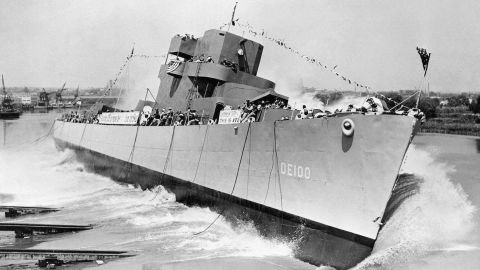Seoul, South Korea
Act Daily News
—
As China continues to develop what’s already the world’s largest navy, a professor on the US Naval War College has a warning for American army planners: In naval warfare, the larger fleet nearly all the time wins.
Pentagon leaders have recognized China because the US army’s “pacing threat.” But fleet dimension numbers present that the US army can’t maintain tempo with China’s naval development.
The People’s Liberation Army Navy (PLAN) surpassed the US Navy in fleet dimension someday round 2020 and now has round 340 warships, in accordance with the Pentagon’s 2022 China Military Power Report, launched in November. China’s fleet is anticipated to develop to 400 ships within the subsequent two years, the report says.
Meanwhile, the US fleet sits below 300 ships, and the Pentagon’s objective is to have 350 manned ships, nonetheless effectively behind China, by 2045, in accordance with the US Navy’s Navigation Plan 2022 launched final summer season.
So to compete, US army leaders are relying on know-how.
That identical doc says, “the world is entering a new age of warfare, one in which the integration of technology, concepts, partners, and systems — more than fleet size alone — will determine victory in conflict.”
Not so quick, says Sam Tangredi, the Leidos Chair of Future Warfare Studies on the US Naval War College.
If historical past is any lesson, China’s numerical benefit is more likely to result in defeat for the US Navy in any battle with China, in accordance with Tangredi’s analysis, offered within the January subject of the US Naval Institute’s Proceedings journal.
Tangredi, a former US Navy captain, checked out 28 naval wars, from the Greco-Persian Wars of 500 BC, by means of current Cold War proxy conflicts and interventions. He present in solely three cases did superior know-how defeat greater numbers.
“All other wars were won by superior numbers or, when between equal forces, superior strategy, or admiralship,” Tangredi wrote. “Often all three qualities act together, because operating a large fleet generally facilitates more extensive training and is often an indicator that leaders are concerned with strategic requirements,” Tangredi wrote.
The three outliers – wars from the eleventh, sixteenth and nineteenth centuries – aren’t doubtless acquainted to all however probably the most ardent of students, however others that present the place numbers beat know-how actually are.
Take the Napoleanic wars of the early 1800s, for instance.
“French warships were superior in the technology of ship design and construction, but ultimately, it was the large numbers of Royal Navy ships that prevented Napoleon from crossing the (English) channel,” Tangredi wrote.
Or World War II within the Pacific, the place Japanese know-how started as the higher of America’s.
“Imperial Japan entered the war with some superior technologies: the Zero fighter, Long-Lance torpedo, and aerial torpedoes that could strike in shallow water,” Tangredi wrote.
“However, it was the overall might of US industry and the size of the US fleet (particularly its logistics and amphibious ships) that ground out victory over the Imperial Japanese Navy,” he mentioned.
Alessio Patalano, professor of battle and technique at King’s College in London, praised Tangredi’s work.
“His research is a very good way to push back on the silly assumption that mass doesn’t matter in war at sea,” Patalano mentioned.
He careworn two key factors.
A bigger dimension means extra leaders trying to acquire the sting of their instructions.
“A larger fleet tend to be more competitive, in training personnel development, and operational capacity,” Patalano mentioned.
And he mentioned a big industrial base is important, particularly in having the ability to construct new models after incurring casualties in battle.
“In naval war, attrition is a real thing, so the ability to replace is vital,” Patalano mentioned.

Tangredi’s have a look at the World War II plane service fleets reveals the stark numbers. Both the US and Japan started the battle with eight carriers, he mentioned.
“During the war, Imperial Japan built 18 carrier-equivalents … while the United States built 144. Unless the United States decided not to fight, Japan never had a chance,” he wrote.
Shipbuilding was a US power when it was the world’s industrial big within the Nineteen Forties. That title now falls to China.
“Most analysts doubt that the US defense industry — which has consolidated and shrunk since the end of the Cold War — could expand quickly enough to meet wartime demand,” Tangredi wrote.
Indeed, there may be fear US business can’t sustain with the demand of offering weapons help to Ukraine to combat Russia’s invasion whereas retaining US weapons arms inventories at sufficient ranges.
Adm. Daryl Caudle, commander of US Fleet Forces Command, final week referred to as on the nation’s protection industries to step up their sport, saying “you’re not delivering the ordnance we need.”
“It’s so essential to winning. And I can’t do that without the ordnance,” Caudle mentioned at a symposium in Washington, including that the US is “going against a competitor here, and a potential adversary, that is like nothing we’ve ever seen.”
In a web based discussion board final week, Caudle’s boss, Chief of Naval Operations Adm. Mike Gilday, additionally famous the numbers downside the US faces in a possible Pacific battle.
“The United States Navy is going to is not going to be able to match the PLAN missile for missile,” Gilday mentioned.
And if the US Navy can’t match China’s missile for missile, or ship for ship, Tangredi wonders the place it might discover an edge.
“US leaders must ask themselves to what extent they are willing to bet on technological — without numerical — superiority in that fight,” he wrote.
“I do not say that a smaller, technologically superior fleet could never defeat a much larger fleet, I only say that — with the possible the exception of three cases in the past 1,200 years — none has.”

